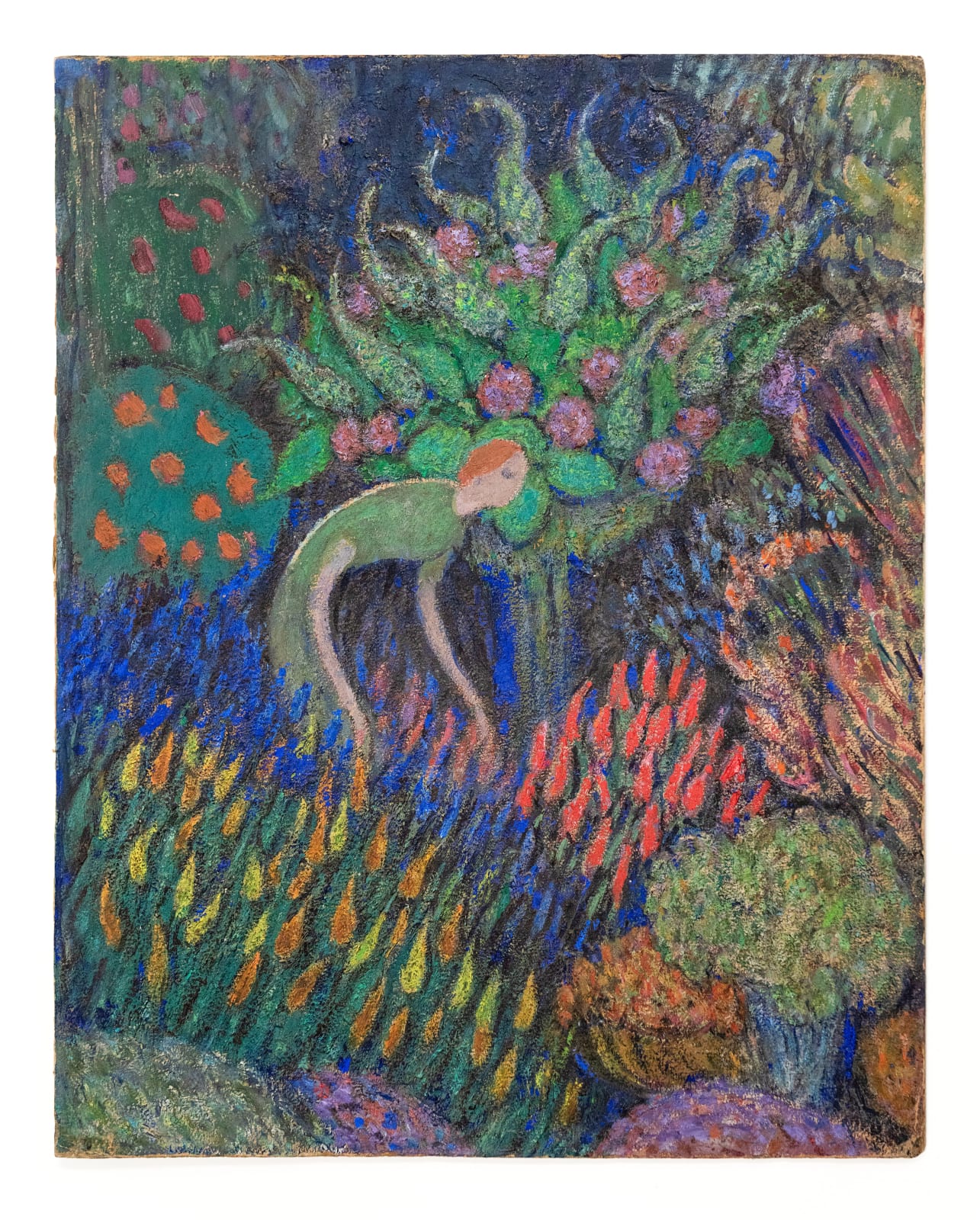

JULIETTE ROCHE Française , 1884-1980
Oil on cardboard
21 x 16 5/8 in
Ce carton représente une femme courbée dans un jardin. Le personnage se dégage dans un paysage luxuriant et idyllique. Les couleurs des plantes vives se dégagent d’un fond sombre. Un jeu sur la matérialité de la peinture donne du relief à la composition et un grand sens du détail est apporté aux fleurs et à l’arbuste du centre de la composition. Toujours à sa manière le reste de la composition est traitée en flou presque abstrait, de grands mouvements colorés sur la partie droite indiquent d’autres types de fleurs alors que sur la partie gauche, on observe une simplification de la représentation de buisson fleurie, une simplification qui tend vers une représentation presque naïve de ces arbustes.
De cette oeuvre, se dégage la luxuriance du jardin qui évoque le Jardin d’Eden. Ainsi, cette toile rappelle le jardin primordial de l’Adam et Eve (1930) de Juliette Roche conservé au Musée Maurice Denis de Saint-Germain-en-Laye, mais aussi la scène idyllique de son fameux American Picnic (1918) conservé au Centre Pompidou.
Au verso de cette oeuvre est peint un paysage représentant Serrières, village qui fait face à Sablon qui accueille Moly-Sabata, la résidence d’artiste que Juliette Roche fonde avec son époux Albert Gleizes en 1927.
__
Born in 1884 and died in 1980, Juliette Roche embodies the women artist of the early 20th century. Her career covered the years 1906 to 1950. Her rich and varied work is marked by important events such as her encounter with the Cubist group in 1913, which led to her marriage with Albert Gleizes in 1915. That same year, the couple moved to New York, where Roche was introduced to the Arensberg circle by Marcel Duchamp. It was during this American period that she took part in the activities of the Dada group and became close to Francis Picabia. Her return to France in the 1920s was marked by the enrichment of her work with various publications.
This cardboard depicts a woman bent over in a garden. The figure stands out against a lush, idyllic landscape. The bright colours of the plants stand out against the dark background. A play on the materiality of the paint gives relief to the composition and a great sense of detail is brought to the flowers and the shrub in the centre of the composition. Again in her own way, the rest of the composition is treated in an almost abstract blur, with large coloured movements on the right indicating other types of flowers, while on the left we see a simplification of the representation of the flowering bush, a simplification that tends towards an almost naïve representation of these shrubs.
The lushness of the garden, reminiscent of the Garden of Eden, emerges from this work. In this way, the painting recalls the primordial garden in Juliette Roche's Adam and Eve (1930), now in the Musée Maurice Denis in Saint-Germain-en-Laye, as well as the idyllic scene in her famous American Picnic (1918), now in the Centre Pompidou.
On the reverse of this work is painted a landscape depicting Serrières, the village opposite Sablon that is home to Moly-Sabata, the artists' residence that Juliette Roche founded with her husband Albert Gleizes in 1927.
Provenance
Fondation Albert GleizesNewsletter
* denotes required fields
We will process the personal data you have supplied in accordance with our privacy policy (available on request). You can unsubscribe or change your preferences at any time by clicking the link in our emails.

